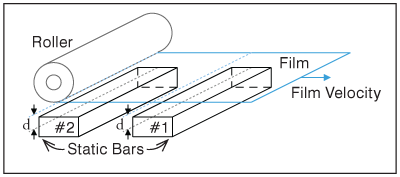Static Beat: The Best Places for Static Bars
- Published: January 01, 2010, By By Dr. Kelly Robinson Contributing Editor
Static bars are highly effective in controlling static charge in film production, coating, and converting operations. To achieve good static control performance, static bars must be properly located in the equipment. Three considerations for proper placement are as follows:
- Position of the bar relative to rollers, machine frame elements, and other conductors
- Film side to be treated or neutralized by the static bar
- Gap between the static bar and the film surface
Position | Both positive and negative corona ions are generated near the tips of the pins in the static bar. The static bar neutralizes static charge or “treats” the film by depositing corona ions on the film surface. The electric field between the film and the static bar attracts ions of the correct polarity to neutralize the film surface. For example, positive corona ions are attracted to negative film charge. Higher levels of static on the film increase the electric field between the film and the nearest conductor. So, it is very important to position the static bar so it is closer to the film than any other conductor as illustrated in Figure 1.

Film Side | To achieve excellent performance, locate static bars to treat the film surface that is charged. In Figure 1, the bottom surface of the film is neutralized. Corona ions move across the gap between the static bar and the film surface to neutralize static. Imagine that these ions were tiny, charged ink droplets that deposit on the film. The ink droplets would produce a visual image of the charge pattern on the film in much the same way that laser printers and office copiers produce images on the photoconductor. Clearly, the visual image would be on the bottom surface of the film. Similarly, ions from the static bar neutralize static or “treat” the film surface facing the static bar.
To determine which side of the film is charged, find the sources of charging in your film path. To determine if a particular roller is a source of charging, use a handheld fieldmeter or static meter to measure the charge on the entering film span and on the exiting film span. An increase in the reading on the exiting span confirms that film charge is higher. Locate your static bar on the exiting span facing the film surface that touched the roller.
Gap | Corona ions move across the gap between the static bar and the film, so it makes sense that static bar performance increases as the gap gets smaller. A bar positioned 1 in. from the film performs better than a bar positioned 1 ft from the film. However, do not position your static bar too close to the film. To see why, look at Figure 2.

Imagine that the static bar has only a single pin located in the center of the film. The ions generated by the pin spread out as they move across the gap. If the film has a uniform charge, the corona ions will deposit in a roughly circular pattern on the film and neutralize a stripe down the center of the film. The width of the stripe is roughly the same as the width of the gap. To avoid stripes, locate the bar so that gap (d) exceeds the pin-to-pin spacing of your static bar. A good rule-of-thumb is for the gap (d) between the static bar and the film to be twice the pin spacing.
Static bars are highly effective in dissipating static charge because they generate many corona ions. This excellent performance is achieved by positioning static bars so they are the closest conductor to the film, so they treat the charged side of the film, and so they are far enough away from the film to avoid “treatment stripes.”
BLOG
Kelly on Static
Visit my blog at http://blog.pffc-online.com/kelly
Static control expert Dr. Kelly Robinson, president of Electrostatic Answers, has 27+ years of experience in problem-solving and consulting. Contact him at 585-425-8158; This email address is being protected from spambots. You need JavaScript enabled to view it.; www.electrostaticanswers.com.




